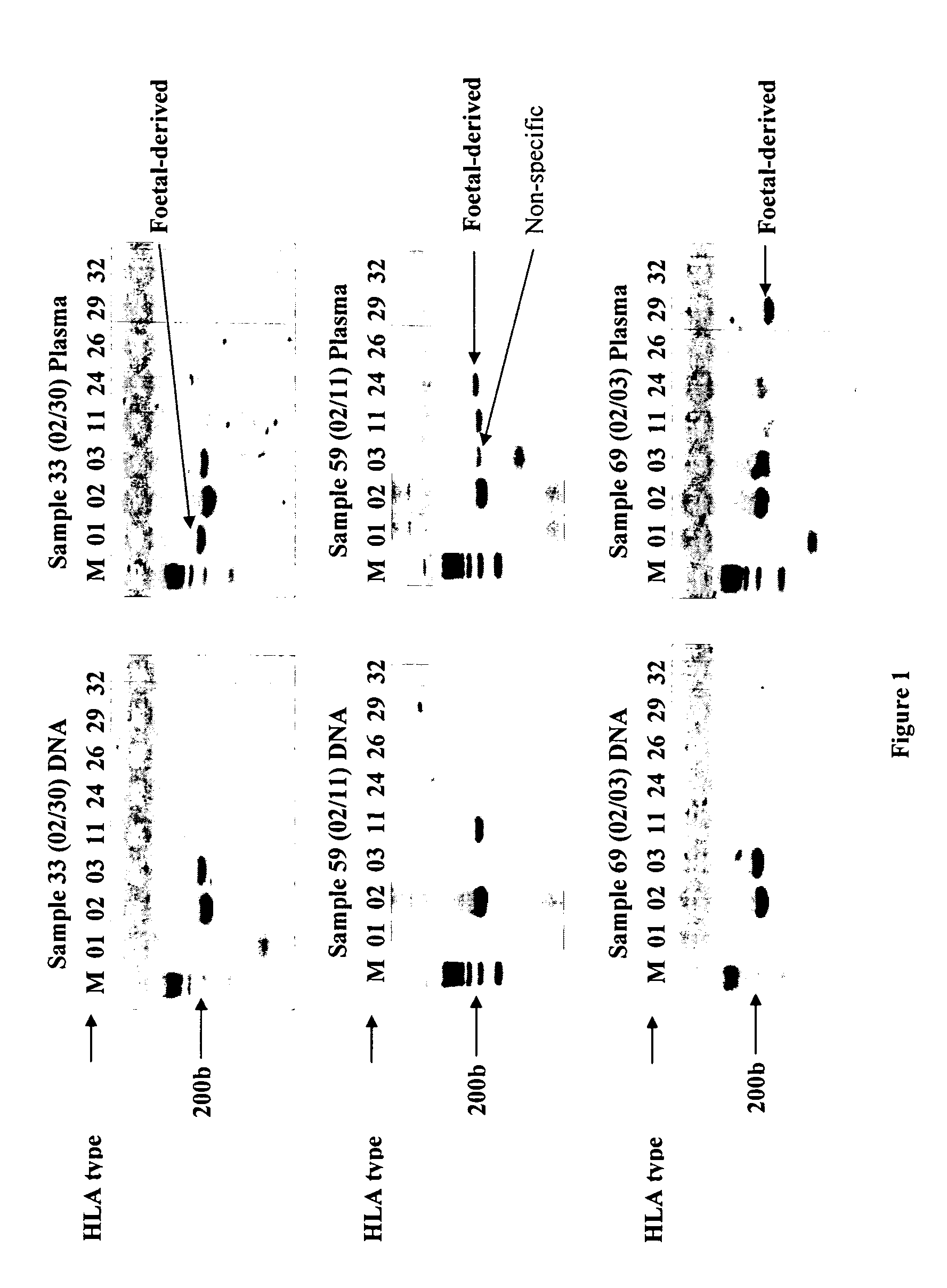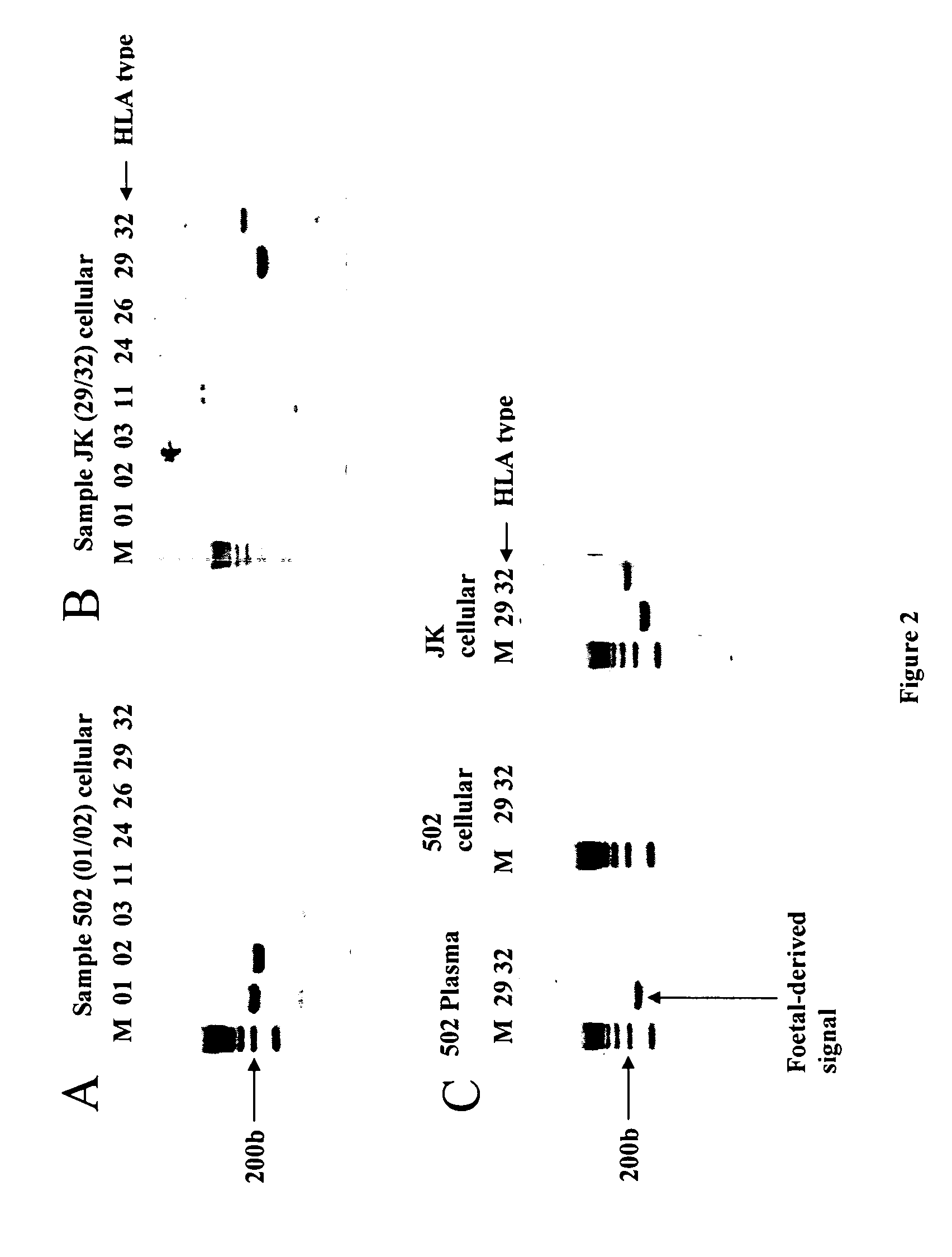Identification of fetal dna and fetal cell markers in maternal plasma or serum
a technology of fetal cell markers and dna, which is applied in the field of identification of fetal specific nucleic acids and fetal cell markers, can solve the problems of not being able to measure the dna of female fetuses, and expose both the mother and the fetus to a certain amount of risk
- Summary
- Abstract
- Description
- Claims
- Application Information
AI Technical Summary
Benefits of technology
Problems solved by technology
Method used
Image
Examples
example 1
Materials and Methods
Isolation of DNA from Plasma
Preparation of Cell-Free Plasma from Whole Blood
[0198] 1. Centrifuge whole blood at 1000×g for 10 minutes [0199] 2. Allow cells to settle for a further 10 minutes [0200] 3. Remove plasma phase with a pipette [0201] 4. Re-centrifuge the plasma phase at 1600×g for 10 minutes [0202] 5. Aliquot plasma into 1.5 ml Eppendorf tubes [0203] 6. Centrifuge at 16000×g for 5 minutes [0204] 7. Transfer cleared plasma to a clean tube for DNA extraction or storage.
[0205] Genomic DNA was extracted from 200 μl of plasma using the Qiagen QIAmp DNA Blood minikit, following the Blood and Body Fluids protocol with the following modifications. The DNA solution was passed through a single column four (4) consecutive times before the wash steps. DNA was eluted from the column using 65 μl of warm (56° C.) 1× PCR buffer (Invitrogen). The eluate was re-loaded onto the column for a second elution. Multiple extractions (200 μl per column) fr...
example 2 (
Prophetic)
[0256] A lymphocyte preparation is obtained form a pregnant female and HLA typed using HLA serological typing trays obtained from Pel-Freez Clinical Systems, LLC (Wisconsin, USA).
[0257] A list of HLA alleles which the mother does not possess is prepared. Preferably, the list is ordered to ensure that the more common HLA alleles are tested first. This will reduce costs, as less HLA alleles should need to be screened before a HLA antigen specific to the fetal cells is identified.
[0258] A maternal plasma sample comprising fetal DNA is prepared as outlined in WO 98 / 39474. The sample comprising fetal DNA is HLA typed for alleles not present in the mother using multiple sets of PCR primers designed to amplify specific HLA alleles followed by the detection of amplification products. Positive reactions (amplification products) will identify HLA alleles present in the fetal DNA but absent in the maternal DNA which can be used as fetal DNA / cell markers.
[0259] If commercial SSP ki...
example 3 (
Prophetic)
Fetal DNA Quantitation Procedure using HLA Type-Specific Standard Curve
[0260] Stocks of HLA-type specific DNA samples are prepared from genomic DNA of blood donors, and their exact DNA quantity is determined by standard (spectrophotometric or chemical) methods. The stocks are stored as single-use aliquots.
[0261] In the instance where fetal HLA typing from maternal plasma using a method of the invention has revealed HLA-A29 to be a unique fetal allele of the fetus a 1:3 dilution series from a stored aliquot of HLA-A29 standard DNA is made, covering a range from 5 ng to 1 pg DNA (=standard curve). A PCR primer pair is chosen that is specific for HLA-A29, for example; Forward CCCACTCCATGAGGTATTTCA (SEQ ID NO:13) and Reverse CTCCTGCTCTATCCACGGT (SEQ ID NO:14). Real-time quantitative PCR reactions are set up, using the standard curve preparation as well as 3-5 replicates of an aliquot (5-40 ul) of the DNA prepared from the maternal plasma (=test samples).
[0262] Reactions ar...
PUM
| Property | Measurement | Unit |
|---|---|---|
| diameter | aaaaa | aaaaa |
| temperature | aaaaa | aaaaa |
| temperature | aaaaa | aaaaa |
Abstract
Description
Claims
Application Information
 Login to View More
Login to View More - R&D
- Intellectual Property
- Life Sciences
- Materials
- Tech Scout
- Unparalleled Data Quality
- Higher Quality Content
- 60% Fewer Hallucinations
Browse by: Latest US Patents, China's latest patents, Technical Efficacy Thesaurus, Application Domain, Technology Topic, Popular Technical Reports.
© 2025 PatSnap. All rights reserved.Legal|Privacy policy|Modern Slavery Act Transparency Statement|Sitemap|About US| Contact US: help@patsnap.com


